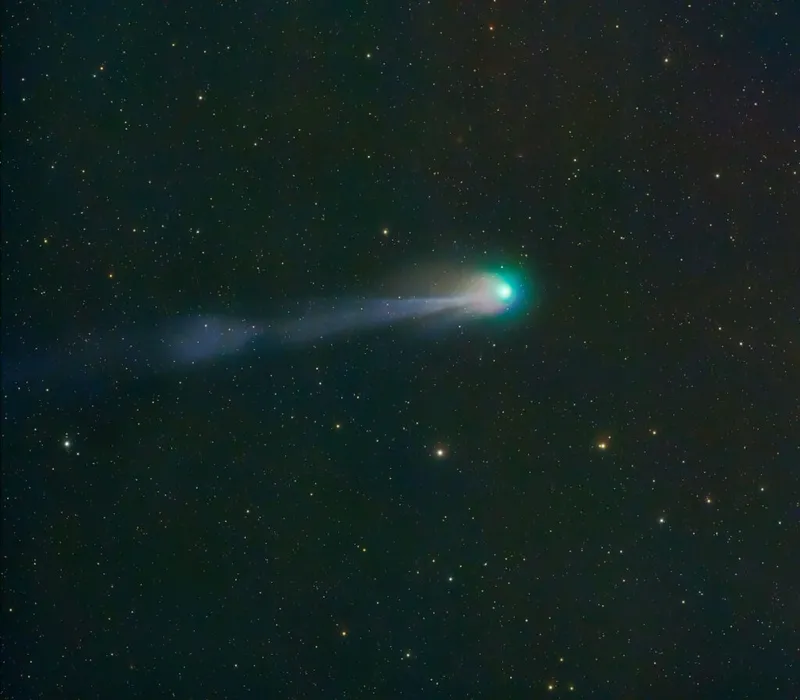Comets and asteroids are the minor bodies of the Solar System. Like planets, they orbit the Sun, but they’re far smaller and often more difficult to find.
Today, most are discovered by large, automated survey telescopes when they are very faint.
In the past, though, many were discovered by amateur astronomers, either visually or photographically, and it’s still an interesting, fun activity to use the same technique to ‘discover’ these objects for yourself.
Find out what comets are visible tonight and read our guide on how to photograph a comet.

Asteroids vs comets
Asteroids are rocky objects, usually in almost circular orbits.
They resemble slow-moving stars, even through large telescopes, and range from small rocks just a few metres across to 940km-wide Ceres.
Meanwhile, comets are dusty, icy objects that generally have elongated orbits.
The solid part of a comet is called the nucleus, which is often a few kilometres in diameter.
As a comet approaches the Sun, some of its ice turns into gas which then flows away from the nucleus, taking dust with it, to form a coma.
The dust and gas can also be pushed away from the nucleus by sunlight and solar wind to form a tail.
Unlike star-like asteroids, comets appear fuzzy due to the coma.
Comets contain material left over from the formation of the Solar System, kept in deep freeze for billions of years.
A rare, bright comet is an extraordinary sight in the sky, but even mundane examples often behave in unexpected ways.

Photographing comets and asteroids
Both comets and asteroids can be discovered using a similar technique: taking images of the same patch of sky, separated by a few hours or days, then comparing the images to look for a moving object.
Since most are discovered by professionals these days, you’re unlikely to find anything new, but it’s rewarding trying this technique on a known object.
You can photograph either type with equipment as simple as a DSLR or as complex as a telescope with a cooled astro camera.
Find out more in our guide on how to use a DSLR camera and DSLR astrophotography.
If you have a fixed tripod, select a bright asteroid as your quarry, since you will only be able to take short exposures.
A mount that can track the stars means you can aim for fainter objects.
Websites like www.in-the-sky.org are a good place to look for targets.
Make sure that your selected object will clear the horizons of your observing site.

Depending on your target’s predicted motion and your field of view, you should take a set of images minutes, hours or days apart.
You can then align them on a computer and ‘blink’ them one after the other. Any moving objects should be obvious.
When you’ve found your target, try your hand at some science by following instructions from the BAA Comet Observing Guide.
You can, for example, measure its position and brightness.
You may not have discovered a new comet or asteroid, but this technique is how discoveries are made.
The only difference is that modern surveys have much larger telescopes and a computer does the checking rather than a human!

What you'll need
A telescope or lens with camera. The greater the aperture, the fainter the object you can capture. Cooled astro cameras work best, but mirrorless or DSLR cameras are fine too
Preferably, a tracking mount. This can be either equatorial or altazimuth, although the latter makes image stacking more difficult
Alternatively, smart telescopes combine optics, sensor and mount into one simple system
Suitable software to stack and ‘blink’ images. Astrometrica is specifically designed for this kind of work, but other options are available
Step-by-step
Step 1

Select a target that’s suitable for your imaging system and high enough in the sky. Observable comets are listed at people.ast.cam.ac.uk/~jds, while www.britastro.org/sections/asteroids is good for asteroids. We chose comet C/2021 S3 (PanSTARRS).
Step 2

Get set up before the Sun sets and check everything works. For best results, you’ll need good calibration frames. These can be collected while waiting for darkness. For flats, you could use the bright twilight sky or a flat panel, depending on conditions.
Step 3

Find your object. This is simple with a Go-To or smart scope. Just enter the object’s coordinates which you’ll find on, for example, the JPL Horizons website. If you’re searching manually, plot a chart of the star field along with the field of view of your system.
Step 4

Start imaging. For comets and asteroids, keep the exposures short, preferably so that the object’s motion is less than one pixel over each exposure. For this subframe of C/2021 S3, I used 120-second exposures. Take multiple frames for stacking later.
Step 5

Calibrate and stack your frames. Astrometrica is a free program that automatically stacks on moving objects, but it has a steep learning curve. ASTAP is another good option. DeepSkyStacker is easy to use, but it may not work with fainter objects.
Step 6

Compare images between sessions and ‘blink’ back and forth between them. Astrometrica also does this efficiently, but other programs can too. It’s easy to spot C/2021 S3 with this pair of images taken 30 minutes apart.
If you're a comet observer or photographer, share your images and adventures with us by emailing contactus@skyatnightmagazine.com

